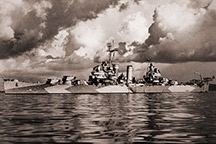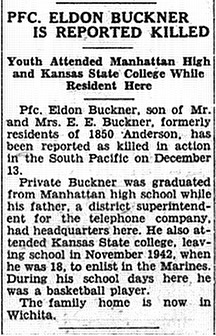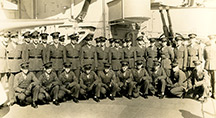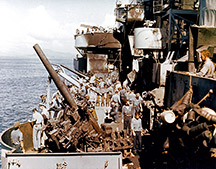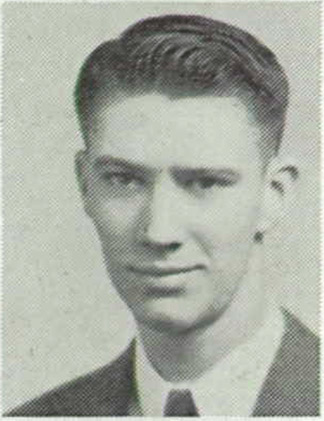Eldon Buckner
Date of Birth: August 8, 1924
Place of Birth: Kansas
Father and Mother’s Names: Eldon and Margaret Buckner, Sr.
Date Entered Service: January 16, 1943
Service Branch: Marine Corps
Service Number: 814081
Rank: Private First Class
Division/Company/Unit info: Marine detachment assigned to the USS Nashville (CL-43).
Awards and Commendations: Purple Heart
Riley Connection: Eldon graduated from Manhattan High School in 1942 and attended Kansas State College.
Date of Death (and Age): December 13, 1944 (age 20)
Place of Death: KIA (Killed in Action) - near the Negros Islands, Philippines.
Grave Location: Wichita Park Cemetery and Mausoleum, Wichita, Kansas.
Bio: Eldon graduated from Manhattan High School in 1942 and attended Kansas State College before entering the Marines in 1943. He served aboard the U.S.S. Nashville, which saw distinguished service in the Pacific, in particular, serving in the North Pacific to defend the Aleutian Islands and attacking Japanese held islands. On December 13, 1944, the Nashville was hit by a kamikaze plane, which crashed onto its deck, and Eldon was killed during this attack.
Kamikaze Attack on USS Nashville: The Marines who were assigned to the Nashville were under the command of Lt. Colonel Thompson. The following is his account of the Kamikaze attack that claimed most of the men under his command, including Eldon Buckner.
"Apparently, to keep us active, we spent most the week patrolling Leyte Gulf, then on December 12th, we set sail for Mindoro Island on the west coast of the Philippines with the Commanding General of the landing force and his staff embarked on the Nashville. Our route took us through Surigao Strait where that last great sea battle was fought on the night of October 24th. It was an eerie feeling to be sailing through the same waters where many US and Japanese ships had been sunk just a few weeks earlier."
"It was known that there were still many operational Japanese air fields located on Mindanao, Negros and other small islands flanking our route. So, we were at our General Quarters stations immediately after getting underway."
"With the exception of my assistant, 2nd Lt. Poul Finn Pedersen, USMC, 1st Sgt. Alton B. Chambers, USMC, and myself, all of the Marines were stationed midship on the boat deck manning the 40mm and 20mm anti-aircraft weapons. Lt. Pederson was the assistant anti-aircraft control officer stationed in the foremast (forward superstructure). 1st Sgt. Chambers was in charge of the two quad 40mm guns, located on the fantail and manned by our wardroom cooks and mess men. I was the anti-aircraft control officer stationed in the mainmast (aft superstructure). Two quad 40mm guns manned by sailors were located just below my station, one on the port and one on the starboard side."
"The first day and night were quiet with no air alerts or other warnings, so we had been placed on One Easy, which meant half of the personnel on station could rest or take a short break. I believe it was about 9 or 10 AM on December 13, 1944, a light cloudy day, that we received an IFF (Identification Friend or Foe) radar alert. Scanning the sky I saw two F4U's well to the rear and crossing the stern of the Nashville to my right (port side of the Nashville) in level flight at about 1500 elevation. (One report I have read estimated the elevation to be about 5000 feet.) I think my estimate was more accurate because I was able to identify the planes as Marine F4Us. This was all observed in a second or two. Seeing the F4Us, we thought the IFF was a false alarm but all of a sudden a plane, that apparently had been closely following the F4Us, veered off and dove for our ship coming directly from our stern. 1st Sgt. Chamber's crew was the only one able to fire a few rounds as the plane banked into the port side clipping its right wing tip on the Quad 40mm below me. The plane slammed into the port side of the boat deck and into two 5-inch AA guns on the main deck. One bomb exploded there, and another bomb was catapulted from the left wing of the plane over to the starboard side of the boat deck, where it also exploded, knocking out the two 5-inch guns there. The 5-inch ammo ready boxes on both sides were open and much of that ammo exploded. The forward superstructure received some damage, causing the AA control located there to be evacuated. The brunt of the explosion was forward, leaving only superficial damage to the after superstructure. Fire raged on the main deck and boat deck in the mid-section of the ship until the Damage Control team was able to extinguish it. The kamikaze plane, which was surprisingly still in one piece, and pilot were pushed over the side with other debris to clear the decks."
"With AA control forward out of action, I established communications with the few AA gun crews that were still operable, alerting them to be on the lookout for any more enemy planes. Fortunately, none appeared. I don't recall how long it was before someone relieved me at my station so I could check on my Marines."
"The devastation was beyond belief. All of my Marines manning the AA weapons on the boat deck and the sailors manning the 5-inch guns in the midship area on both the starboard and port side were wounded or killed. The wounded were evacuated to emergency medical facilities established in the officers' wardroom and the crew's mess hall for treatment, and the KIAs were moved to the hanger deck. The Landing Force Commander and his staff, who weren't wounded or killed, were transferred to the USS Boise, as I recall. The Nashville, escorted by two escort ships, immediately returned to San Pedro Bay, Leyte, where the wounded and dead were transferred to Army Medical facilities ashore for treatment or burial. We had no time to sort out the personal belongings of the wounded to send ashore with them. However, I did transfer the individual personal records of the wounded ashore with them to the Army Medical Field Hospital."
Of the 40 men in 1st Lt. Thompson’s detachment, 19 were killed. Only three Marines survived the attack uninjured: 1st Lt. Thompson, 2nd Lt. Poul Finn Pedersen, and 1st Sgt. Alton B. Chambers.
